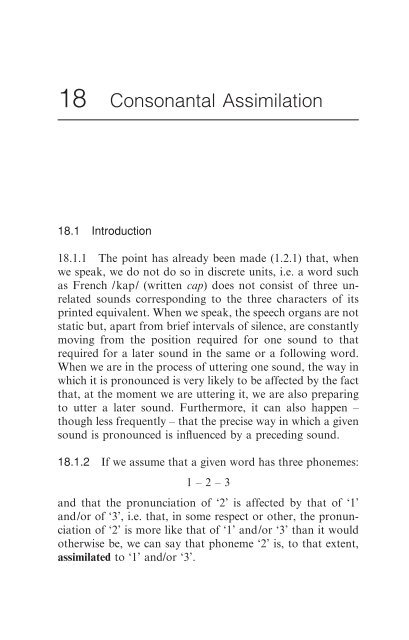An Introduction to French Pronunciation
An Introduction to French Pronunciation
An Introduction to French Pronunciation
Create successful ePaper yourself
Turn your PDF publications into a flip-book with our unique Google optimized e-Paper software.
122 Consonantal Assimilation<br />
18<br />
18.1 <strong>Introduction</strong><br />
Consonantal Assimilation<br />
18.1.1 The point has already been made (1.2.1) that, when<br />
we speak, we do not do so in discrete units, i.e. a word such<br />
as <strong>French</strong> /kap/ (written cap) does not consist of three unrelated<br />
sounds corresponding <strong>to</strong> the three characters of its<br />
printed equivalent. When we speak, the speech organs are not<br />
static but, apart from brief intervals of silence, are constantly<br />
moving from the position required for one sound <strong>to</strong> that<br />
required for a later sound in the same or a following word.<br />
When we are in the process of uttering one sound, the way in<br />
which it is pronounced is very likely <strong>to</strong> be affected by the fact<br />
that, at the moment we are uttering it, we are also preparing<br />
<strong>to</strong> utter a later sound. Furthermore, it can also happen –<br />
though less frequently – that the precise way in which a given<br />
sound is pronounced is influenced by a preceding sound.<br />
18.1.2 If we assume that a given word has three phonemes:<br />
1 – 2 – 3<br />
and that the pronunciation of ‘2’ is affected by that of ‘1’<br />
and/or of ‘3’, i.e. that, in some respect or other, the pronunciation<br />
of ‘2’ is more like that of ‘1’ and/or ‘3’ than it would<br />
otherwise be, we can say that phoneme ‘2’ is, <strong>to</strong> that extent,<br />
assimilated <strong>to</strong> ‘1’ and/or ‘3’.












